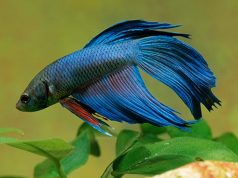Betta fish color variation is based on the color pigmentation in different types of cells. These color cells are in layers within the skin. In the bottom-most layer are the xanthophores which produce a yellow color. The next layer of pigmented cells are the erythrophores, which produce the red color. On top of these are the melanophores which produce the black color. Finally, on the top-most layer are guanophores (iridophores) which produce the green and blue iridescent colors. These different types of cells have groups of traits associated with them. For example, the erythrophores (red cells) have the extended red trait (red covering the whole body and fins), the non-red trait (the complete absence of red) and the wild-type trait (erythrophores covering portions of the pelvic, anal and caudal fins and parts of the body). These traits are determined by the genes of the fish.
Some of the genetics are characterized, however the characterization is not very well defined. For most biosynthetic pathways a group of genes encode for the enzymes which catalyze a series of reactions to produce a specific pigment.
If any genes in the pathway were mutated such that an enzyme no longer worked, the pigment would no longer be produced. This may be the case for the non-red trait. However, the extended-red trait is likely due to an expression of a functional protein involved in the regulation of the entire pigment biosynthetic pathway. In other words the pigment biosynthetic pathway can be turned on or off by protein “switches” in different parts of the fish. These “switch” proteins (regulatory proteins) can either work to “turn on” genes in specific regions of the fish or can work to “turn off” the genes, depending on where they are in the fish as would be seen in a trait like the butterfly trait. Additionally these regulatory proteins can also be influenced by external stimulus (water conditions, feeding or during spawning).
So traits (also known as phenotypes) are what we see and the genes that make up the traits (also known as genotypes) contain the information for the proteins that catalyze the reactions to produce the pigment we see. It can be very complicated, and when breeding fish outside of an established strain–anything can happen!
(Extracted From : A Complete Authoritative Guide Siamese Fighting fish
by Gene A. Lucas, Ph D. ISBN 0-7938-0120-6 )



